SVCC and the serious problems with the outfield of the Main Ground.
As most members and former players have noticed, the standard of the outfield on the main ground at Shenley has gradually worsened over the past 10 years, but the near drought like conditions of the 2018 season really accelerated the deterioration, as it did with cricket grounds all around the country. Our Main ground was particularly in need of attention. Some grass never grew back and in its place abundant moss flourished, growing on top of the 2 cm of thatch that had built up over the last 25 years. There were constant dips and bumps, rabbit diggings, bare patches, weeds and moss galore, drainage lines and cracks in the soil.
This story of the grounds past and present needs to be rewound at this point in order to understand the full context.
The Herts County Cricket Secretary, Derek Dredge, had asked Chris Wood in late 1989 if he could improve the almost derelict Shenley Hospital cricket ground back into good condition towards the planned development of a Herts County Cricket Centre of Excellence. By 1991-92 the Shenley outfield and wicket had started to attract a good standard of fixtures, including Herts County representative sides.
Chris had commenced work in 1990, and living on site in the South Lodge former gate house, he spent every hour of daylight on the ground, mostly on his own and with very little budget or machinery, but he loved the challenge and the freedom to be resourceful. The ground was improved to such an extent that by 1996 it was universally regarded as the best in Hertfordshire and as a club ground one of the best in the country. As a club we just loved being able to get the odd league game on this beautiful surface. We also saw the opening of the nursery ground, which became our home ground from 2000 until 2014 when we gained the use of the main ground as well, ideal for our 4 Saturday teams. Using the nets at Shenley and playing just 5-10 games a season on the main ground, our membership grew, bucking the trend with a Junior Section added, a 3rd senior team in 2000 and a 4th team in 2007.
From 1998 all Herts County finals were played at Shenley, and until 2009 it was a great relationship. But our club was still working with the Saturdays and Sundays left unbooked, and only played on the main ground when we were not outbid by a higher paying game. Our £100 per game filled in the gaps to our mutual convenience but the ground had at least one full time groundsman all season.
Shenley’s main ground attracted a lot of attention, and the ECB started using it as the venue for the first game by all international touring sides. Apart from Australia all the other international sides played at Shenley plus women's test matches, County A games, and even the England Lions enjoyed the billiard table like outfield and the fast and flat wicket. One season the first class umpires gave Shenley marks that placed it 2nd in the land in the county 2nd eleven competition for the wicket and the outfield, only behind Trent bridge. The groundsman for a few years at that time was Andy Atkinson, who is currently the ICC Grounds Consultant, and he brought his own stamp of very highly qualified, Test and County experience.
Shenley was a factor in Chris Wood being given the top groundsman job in the UK, the ECB inspector of pitches. However the ECB's gain was Shenley’s loss. The MCC were also seriously considering taking over the lease to make Shenley their 2nd ground but they dropped that idea when they found it could not be a members only facility.
Since the arrival of Arthur, our current groundsman, the wicket table has much improved but the outfield needed considerable work. Even so the facility marks given by the visiting captains and umpires still remain near the top in the divisions where our teams currently play. In an effort to improve the clubs facilities we have since 2012 picked up over £120,000 of funding to provide the club with excellent practice nets, digital scoreboards, sight screens, covers, batting cages, and boundary ropes. We have continued to have regular promotions and age group winners every year, which underlines the strength of the clubs players, coaching and on the field performances.
Focusing back on the main ground, 2020 saw an even bumpier outfield, and the thick moss, particularly on the far side away from the pavilion was almost all moss, resulting in the ball travelling slower and slower and often failing to reach the boundary. Even when hit hard the ball tended to dig in and jump, often deviating in direction and being somewhat dangerous on occasions for fielders. After rain it would retain a lot of moisture and we would depend on evaporation rather than it draining through the ground or into the old drainage system.
In recent years core samples were taken from the outfield and they clearly showed the soil was bone dry less than 2 inches down. Above that was old grass, moss, and a sort of 'skin' preventing water or oxygen from penetrating to where it is most needed, the roots of the grass. There was no grass root growth, no drainage or oxygen to feed those struggling roots. The outfield for the major part was barely alive and in urgent need of nutrients, fertiliser and worm control.
With a grant from Tesco's we asked for an analysis of the problem and what was needed to rectify. Reports were given by AT Bone and Sons, a major local grounds contractor, and another by Andy Clark a former full time Shenley groundsman and the former ECB/IOG South of England Regional grounds advisor. We talked them over extensively with Chris Wood, the just retired ECB head pitch inspector, father of our own top wicket taker Kevin Wood.The conclusion was that the main ground needed not just churning up, and grass seed, but the complete removal of the current surface and the laying of a new surface of rich soil and sand, re-grassing and verti-draining to provide the much needed water, oxygen and fertiliser deep into the soil.
At the end of the 2019 season Chris, Arthur and I had several serious chats. Earlier in that season Geoff and I attended a sponsored groundsman’s seminar in St Albans run by Chris for all the groundsmen in and around Hertfordshire. The speakers included the head of grounds staff at Twickenham and Man United, and some of the top machinery suppliers, it was all very educational and enhanced our understanding of the full treatment Shenley needed.
Earlier both A T Bone and Andy produced extensive written reports in 2018 and 2019, both of which were used for grant applications and to create awareness with our own club committee. We did manage to pick up a couple of small grants that were used to improve the drainage below the bank and car park, and the wicket table. The work was carried out by contractors, but non-recommended sand was used, although the verti draining (8-10 inch holes punched into the outfield surface) did have a very good effect on the drainage of both grounds.
Our landlord employed the golf course staff to regularly cut the outfield grass and do the wicket renovations at the end of each season. 2018 on a limited budget was a poor end of season renovation with many bare patches and no weeds removed on either wicket. It was only with Arthur’s arrival that the wickets immediately became greener with much needed watering and the bounce became more even. Despite this, the previous years of under investment had let the standard fall so far and we needed to get a lot more help in order to improve the standard sufficiently for good quality club cricket and to justify the increased membership fees needed to cover the roughly £20,000 p.a. ground hire and maintenance costs to use both pitches at Shenley. End of season wicket renovations in 2019 were improved, but still not professional enough. Arthur and Dave were doing an admirable job but could only do so much on a limited budget and with this alone we were not going to take the necessary leap forward. We did not have the necessary machinery, experienced manpower or money to get the sick patient better.
Our situation became even more extreme when our landlord lost all his 2020 income with the Covid 19 lockdown resulting in the cancellation of all weddings and gatherings. All staff were furloughed and then laid off, and Geoff negotiated for our club, in exchange for forgoing rent, to pay all the ground maintenance costs so we could at least take care of the wickets on both grounds, we could be ready to play when the season started and keep our groundsman for the future. In addition the club could not collect the normal membership fees to run a cricket club if we didn't have cricket to play. We had no bar to offer our socially distant universe of players, parents and supporters even if we did start playing again, as it became clearer during May and June that we might. The Junior League season failed to start, was subsequently cancelled and replaced by training and friendly matches.
A general appeal had to be made to our members asking for donations just so we could keep Arthur and give the grounds the maintenance they needed. But no renovations would be possible unless we as a club took on the task. The break in cricket did provide a window of opportunity to consider getting the job done.
The Solutions
Coming out of the winter and into the spring of 2020 we were all caught up in the news of a virus in China, causing a whole city to be locked in their homes. Before we knew it March saw us locked in as well, and even with the beginning of the cricket season still 6 weeks away no one was confident it would start, and so it proved to be.
All winter I had been asking A T Bone for a quotation to renovate the main ground outfield which was our most urgent need. For some reason they did not reply. Not until I had at least one estimate could I apply for a grant or multiple grants to get the work done as needed, and the absence of cricket could mean we had the summer months to work on the outfield if the funds could be in place.
Thankfully Chris knew a number of top groundsmen who could also provide quotes. It was important to us that we had an experienced project manager to pull the whole job together and at the same time work with us in the longer term to follow up on the initial work, particularly the following preseason. Finding the right person, and booking them early enough was our new goal and once we had the costs worked out I began putting together the necessary funding to get the best possible job done.
Chris had stressed that many grounds, even Shenley in the past, have rotavated the surface, cleaned out the grass, levelled it off and thrown some grass seed on it. But what our ground needed was the complete removal of the surface to a depth of 2-3 centimetres! The top surface was dead and would only continue the problem if we didn't dispose of it somewhere away from the cricket ground.
Sure enough we found an excellent contractor in the guise of Keith Exton the former head groundsman at Sophia Gardens, home of Glamorgan CCC and a test match ground. I committed to the project and Geoff cleared the plan with our landlord, as without his permission and encouragement nothing stable could be achieved for the club’s future seasons. We also cleared the plan with the Shenley Park Trust, the ultimate owners of the ground and the club committee was briefed on the need and the intended works programme.
A meeting was set up for Keith to inspect the grounds, the wickets and to enable him to prescribe the best possible course of treatment to get the ground back to full health. Keith was introduced to the committee members involved, and less than a week later we received a complete quotation for a course of work that involved removing the surface, aerating the surface by punching holes into the ground to open it up for oxygen and water, then levelling the surface with both mechanical combs and lutes. The plan was then to plant a variety of grass seeds into the soil just below the surface, covering it with 200 tons of sand and soil plus 50 tons of slow release fertiliser containing all nutrients required for good grass growth deep into the winter. Chris was still very mindful of the drainage lines, and many other characteristics of the ground, which he also passed on to Keith and Arthur, who was the student learning from the masters at work with the serious equipment needed for such an ambitious project. Around the same time in late June, Geoff and I heard we had landed a £4000 grant from Sport England and this was extra encouragement and the first of several sources of income that started to come in.
As the season got underway in mid-July, so could our planning and by late August we had all the “i's” dotted, and “t's” crossed, paid the deposit, and set a starting date of 14th September,one day after the last league game. Eventually a real spirit of cooperation came together with the Park Trust lending us a tractor and trailer, the golf course also lending a tractor and trailer with a driver, help from the Cricket Centre management and even the land owner next door allowing the club to dispose all the old spoils from the ground onto his unused field next door. An estimated 50 tons of old grass and moss was removed, the disposal of which could otherwise have been really troublesome. All in all we had 4 tractors involved and 6 different fittings for various jobs, along with 6 men, and it all took 7-8 days with a day lost to mechanical troubles.
Although we were enthusiastic to have the wicket table fully renovated at the same time, it was initially decided not to take up that option and just have a cheaper job due to the low use of the square in 2020. However, once it became clear that we would make significant cost savings by having the full service done while the equipment was on site, we quickly added the whole wicket table to the job, taking off the saddles that had built up at each end and levelling the table.
100 kgs of grass seed were applied, 100kgs of fertiliser, and 5000kgs of loam, all levelled and bedded in. The loam from the main ground could then be used to fully scarify and renovate the nursery ground. Long dusty days were spent levelling the entire outfield and removing the old roots, filling in the dips and shaving down the mounds. Then the seeding machine covered the wicket and the outfield and the wicket fertiliser gave the square a lavender colour. Meanwhile the topsoil and sand was added to the outfield along with the appropriate fertiliser.
We were all delighted to see that rain was forecast and the day after everything was completed it rained right on cue, on the 23rd September. Up to then it had been hot and dusty as you can see from the photographs below.
By 3rd October the first grass shoots appeared and by the 10th the whole ground was green. On the 6th November the wicket was cut for the first time, more fertiliser applied, and an organic mixture was added to keep the worms off the wicket area. However due to the many worm casts being predominant and soft it was decided not to cut the outfield just yet. The roller on the mower would just smear the worm casts and damage the young grass underneath it.
There will be more attention paid to the outfield and wicket areas over the winter months but the real polishing of the playing areas will be mostly evident in the spring, with most of March and April available to bring the surfaces into looking and playing at its best. By the start of the season I am hoping we will have financed our own outfield mower so we can cut the grass 2 or 3 times a week as is needed for the rye grass we have coming through. Before then a full worm treatment and verti-draining of both outfields will be carried out.
However the big renovation has now taken place. The major surgery has been successful and the surgeons are happy with the results. If you want to help out with the ongoing work needed to maintain the Shenley grounds in tip top condition please feel free to contribute. You can speak to Geoff, George, Sammy Saleh or Arthur as all contributions will be gratefully received.
The Solutions now need to be supported and maintained and hopefully built into the clubs culture.
Ray McLennan
November 2020
See below for photographs: This page will be regularly updated as the story continues and the benefits are realised.
The Shenley main ground is roped off and closed to dog walkers, and the public in general (below).
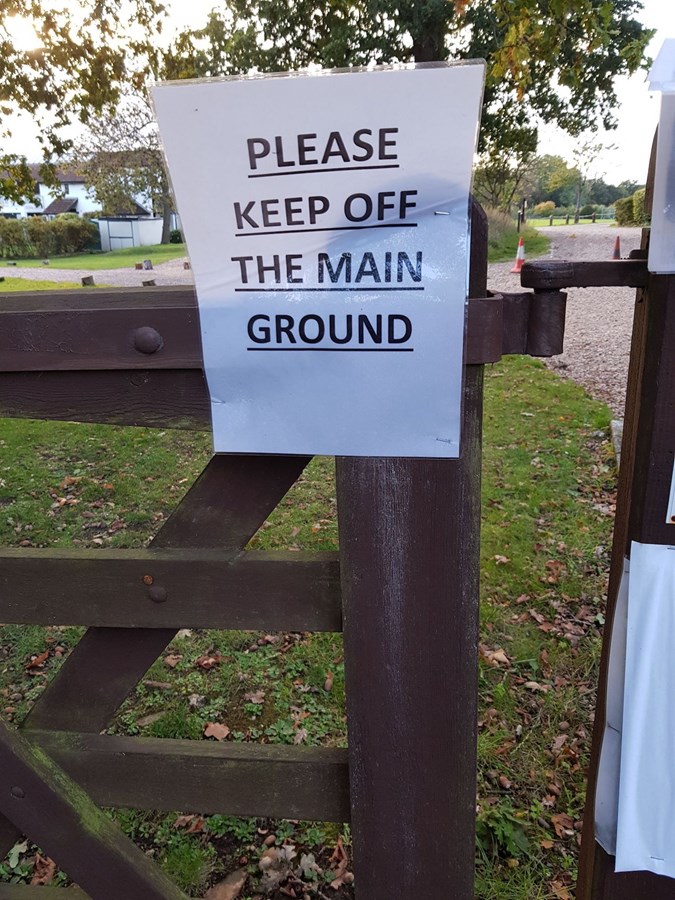
By October 3rd we had 2-3 days of constant rain and the flatness of the
surface can be seen from the even sheet of water as it soaked into the
warm soil. All of October was warm and mild day and night, ideal for
germination and growth (below).
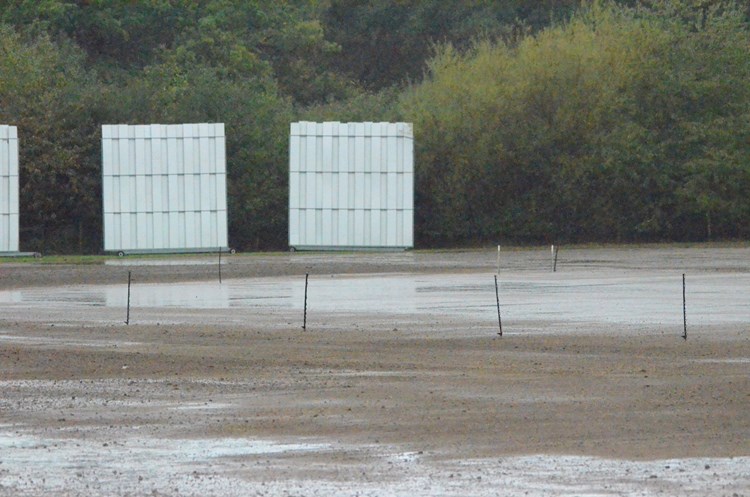
More like a lake! (below)
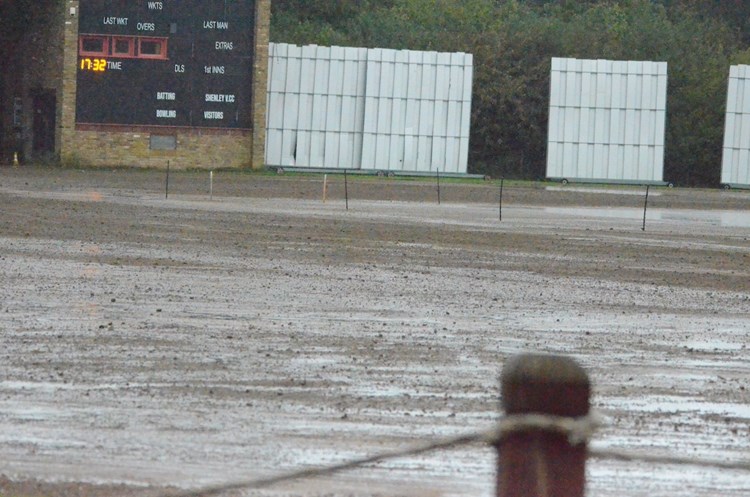
October 3rd. First showing of the new grass germinating, after the rain. In
neat lines and evenly spaced. More like a commercial crop than an open
field (below).
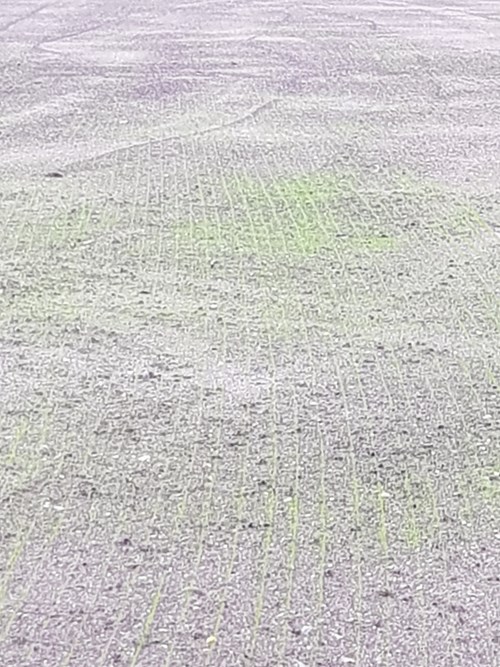
From the first rains, the first grass began showing within a week (below).
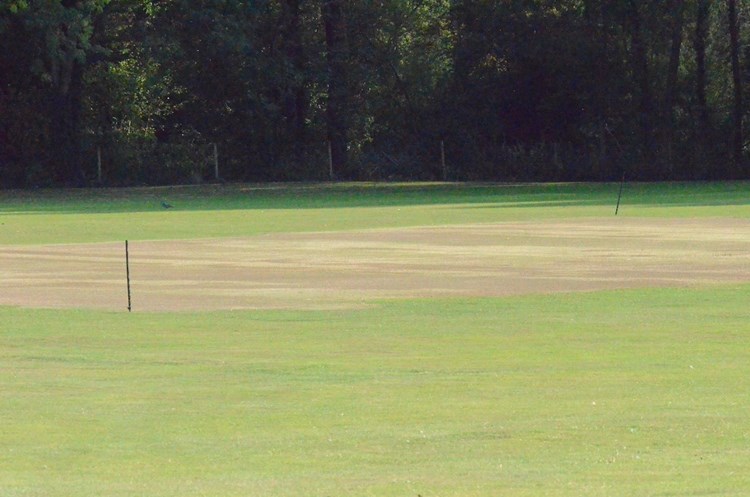
By the 20th Oct.we have a lush covering of fresh rye grass, no moss, no weeds!
(below)

6th November. Fertiliser spread on the new grass outfield (below).
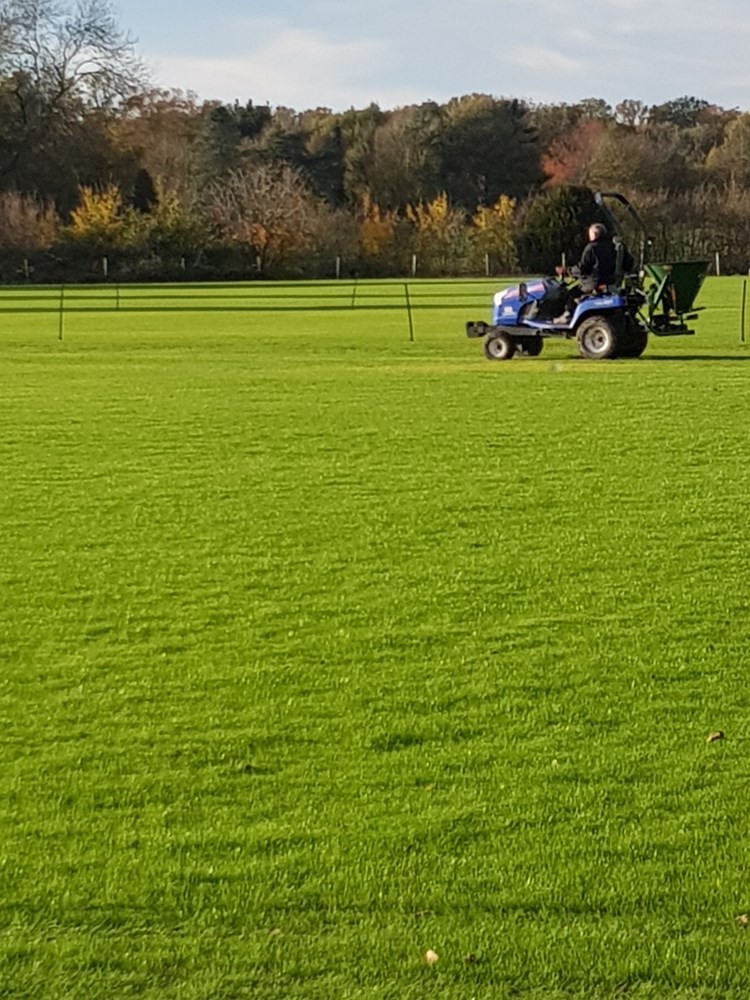
The wicket table gets its first cut (below).
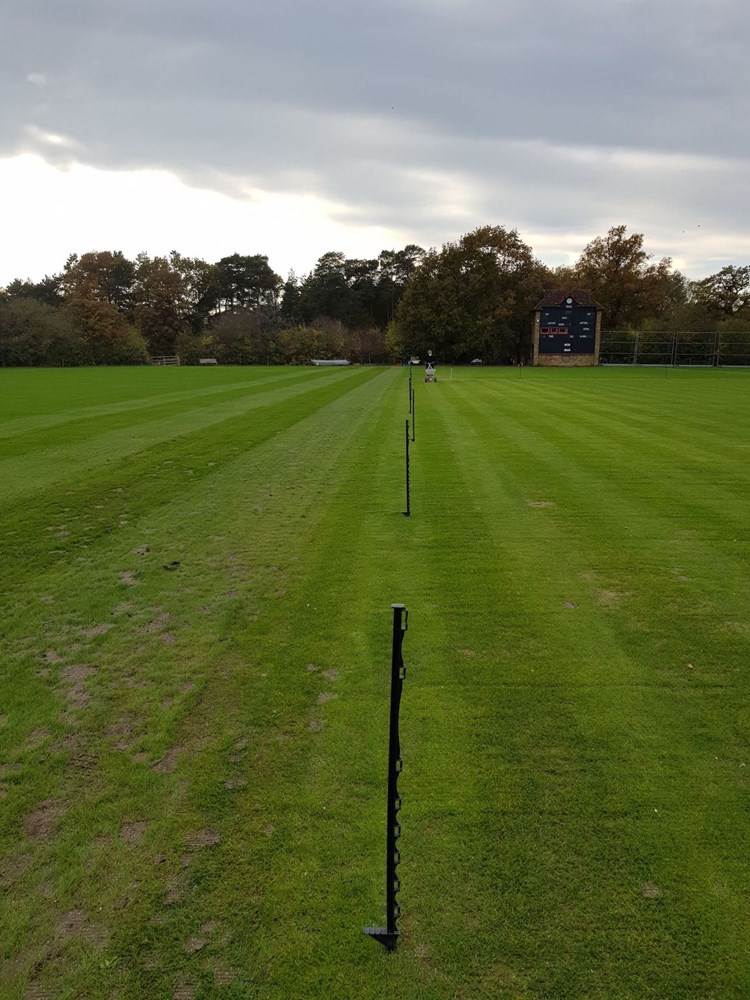
Wicket is treated with slow release fertiliser for the winter (below).
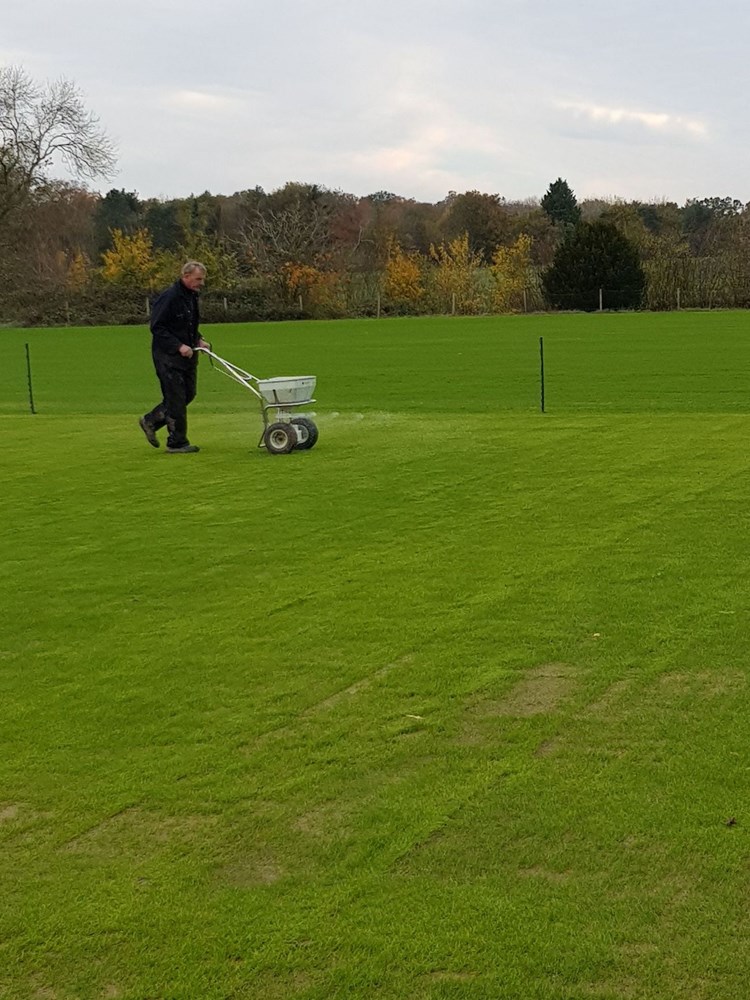
To be continued......